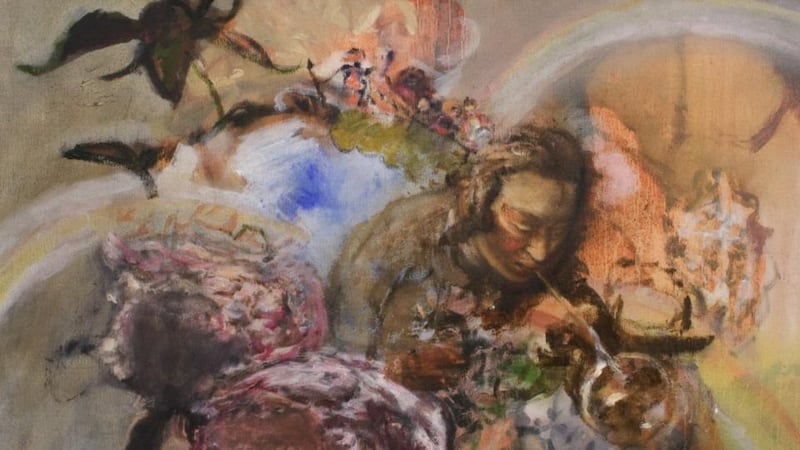Margaret Corcoran is known for her lively engagement with the Western painting tradition. Her acclaimed 2002 exhibition An Enquiry, pictured her daughter looking at some of the paintings that make up the Milltown bequest in the National Gallery of Ireland. The enquiry in question was ostensibly Edmund Burke's 1757 Philosophical Enquiry into the Origin of Our Ideas of the Sublime and the Beautiful, a key text in heralding the Romantic era, and an influence on many of the artists whose work makes up the bequest.
But the young woman’s assertive presence, and her quizzical, enquiring gaze also raised the question of women’s place in the aesthetic order.
Corcoran has, ever since, questioned and debated with the canon rather than accepted it. Her brilliant reworking of Manet's masterpiece Bar at the Folies Bergéres (which is worth a visit to the Courtauld in London just to see it) substitutes a Chinese woman working behind the counter at a local supermarket for Manet's barmaid. For her new exhibition at Solstice Arts Centre in Navan, Corcoran found her way back to the National Gallery.
Looked to the wilderness
There, one day, she was taken with Jonathan Fisher's exceptional, spare 1769 landscape A View of the Lower Lake, Killarney. From the parkland of Kenmare House, Fisher turned his back on the orderly, neoclassical landscape and looked to the wilderness, an untamed expanse of mountains and water – in line with Burke's notion of the sublime.

His painting features a tall, spindly tree just off centre in the foreground. Using a tree to frame a composition and set up a sense of depth is a routine pictorial device, but here, as in other of his paintings, it struck Corcoran that Fisher places the tree in a prominent position, so that it becomes a subject rather than a prop, an almost Beckettian character.
Casting further afield, she began to see Fisher's tree, or variations of it, in other paintings by, among others, Breughel and Rubens, by Austrian artist Peter Wenzel, and in a Piranesi etching.
Breughel and Rubens were depicting the Garden of Eden, as was Wenzel – his version is in the Vatican. “Once you begin to look closely,” Corcoran says, “You see networks of connections from painting to painting, as artists borrow wholesale from each other.
“I didn’t realise that Rubens is actually well known for his visual “quotations”. You find figures, trees, animals and compositional groupings recurring from artist to artist. Photoshop had nothing on them.”
Fisher’s tree quickly led Corcoran into a dense thicket of iconography. Trees have female connotations from early on, as symbols of fecundity and renewal. The myth of Apollo and Daphne sees the nymph Daphne transformed into a laurel, a story that has inspired numerous artists. Cupid had cruelly set the couple at cross-purposes, inspiring love in Apollo and fierce antipathy in Daphne. Fleeing, she appeals to her father, Peneus the river god, who inventively transforms her into a bay tree.
“When we get to the Garden of Eden,” Corcoran notes, “we get the “Blame the woman” story, with Eve, who takes the fruit from the tree of knowledge.”
From this tangled iconographic history she has devised her own revisionist treatment, taking her cue from Ovid's Metamorphosis: "You can follow stories back through generations of paintings. One is transformed into the next." In that spirit she's made a few transformations of her own, including Fisher's tree as Daphne and Daphne as Eve,
Cythera
She's called her exhibition Return to Cythera. Mythically, Cythera is the island of Aphrodite or, in Roman mythology, Venus, the goddess of love. More recently it becomes the apocryphal Greek island Kalokairi in the film Mamma Mia.
Cythera features in key works by the great 18th century French painter Jean-Antoine Watteau. He also transformed the mythic island to suit his own dramatic purposes.
“Watteau devised this extraordinary theatrical way of depicting people in the landscape, inventing a whole new pictorial mode, the “fête galante” with costumed characters, including lovers, in beautiful pastoral settings.” It seemed to her that Watteau’s evocations of Cythera were in a sense versions of Eden.
As with Burke, he was a transitional figure, moving from baroque to Rococo. She liked that he could see painting as a kind of theatre, and that is pretty much what she does.
The paintings in An Enquiry demonstrated she is a conventionally gifted draughtsperson and painter, absolutely at home with representational method. But the last thing she wanted to do was to create pastiches of Neo-classical or Romantic paintings. She takes a bravura, tremendously free approach in Return to Cythera, building up densely layered networks of imagery – you have to look at each image closely or you'll miss much of what's going on.
Sometimes she’ll work a section of a composition to a polished conventional finish, but she always holds back from creating an overall, seamless illusion. There’s a lightness of touch, a very appealing playfulness. When she veers towards abstraction with, say, expanses of saturated colour or flurries of calligraphic brushwork, it’s beautifully judged. The historical material she is dealing with becomes a rich nutritive mass from which she draws not new stories but – as ever – new versions of old stories.
Return to Cythera: Paintings and works on paper by Margaret Corcoran is at Solstice Arts Centre, Navan until June 7. solsticeartscentre.ie











